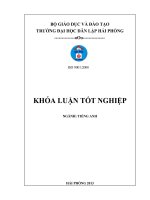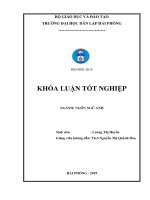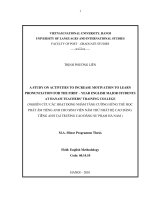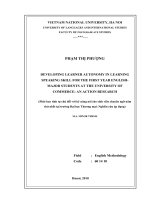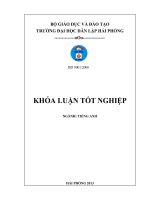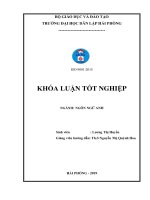motivation for the first year english major students in listening courses
Bạn đang xem bản rút gọn của tài liệu. Xem và tải ngay bản đầy đủ của tài liệu tại đây (534.73 KB, 67 trang )
BỘ GIÁO DỤC VÀ ĐÀO TẠO
TRƯỜNG ĐẠI HỌC DÂN LẬP HẢI PHỊNG
--------------oOo---------------
ISO 9001:2008
KHĨA LUẬN TỐT NGHIỆP
NGÀNH: TIẾNG ANH
HẢI PHỊNG 2013
BỘ GIÁO DỤC VÀ ĐÀO TẠO
TRƯỜNG ĐẠI HỌC DÂN LẬP HẢI PHÒNG
-----------------------------------
GRADUATION PAPER
MOTIVATION FOR THE 1ST - YEAR ENGLISH
MAJOR STUDENTS IN LISTENING COURSES
KHĨA LUẬN TỐT NGHIỆP ĐẠI HỌC HỆ CHÍNH QUY
NGÀNH: TIẾNG ANH
Sinh viên : Vũ Thị Ngân
Lớp: NA1301
Giảng viên hướng dẫn: Ths. Nguyễn Thị Quỳnh Chi
HẢI PHÒNG - 2013
BỘ GIÁO DỤC VÀ ĐÀO TẠO
TRƯỜNG ĐẠI HỌC DÂN LẬP HẢI PHÒNG
--------------------------------------
NHIỆM VỤ ĐỀ TÀI TỐT NGHIỆP
Sinh viên: ............................................................Mã SV:............................
Lớp: .............................Ngành:....................................................................
Tên đề tài: .................................................................................................
..................................................................................................
NHIỆM VỤ ĐỀ TÀI
1. Nội dung và các yêu cầu cần giải quyết trong nhiệm vụ đề tài tốt nghiệp
( về lý luận, thực tiễn, các số liệu cần tính toán và các bản vẽ).
……………………………………………………………………………..
……………………………………………………………………………..
……………………………………………………………………………..
……………………………………………………………………………..
.
2. Các số liệu cần thiết để thiết kế, tính tốn.
……………………………………………………………………………..
……………………………………………………………………………..
……………………………………………………………………………..
3. Địa điểm thực tập tốt nghiệp.
……………………………………………………………………………..
……………………………………………………………………………..
……………………………………………………………………………..
CÁN BỘ HƯỚNG DẪN ĐỀ TÀI TỐT NGHIỆP
Người hướng dẫn thứ nhất:
Họ và tên:.............................................................................................
Học hàm, học vị:...................................................................................
Cơ quan công tác:.................................................................................
Nội dung hướng dẫn:............................................................................
Người hướng dẫn thứ hai:
Họ và tên:.............................................................................................
Học hàm, học vị:...................................................................................
Cơ quan công tác:.................................................................................
Nội dung hướng dẫn:............................................................................
Đề tài tốt nghiệp được giao ngày 25 tháng 03 năm 2013
Yêu cầu phải hoàn thành xong trước ngày 29 tháng 06 năm 2013
Đã nhận nhiệm vụ ĐTTN
Đã giao nhiệm vụ ĐTTN
Người hướng dẫn
Sinh viên
Hải Phòng, ngày ...... tháng........năm 2013
Hiệu trưởng
GS.TS.NGƯT Trần Hữu Nghị
PHẦN NHẬN XÉT CỦA CÁN BỘ HƯỚNG DẪN
1. Tinh thần thái độ của sinh viên trong quá trình làm đề tài tốt nghiệp:
……………………………………………………………………………..
……………………………………………………………………………..
……………………………………………………………………………..
2. Đánh giá chất lượng của khóa luận (so với nội dung yêu cầu đã đề ra
trong nhiệm vụ Đ.T. T.N trên các mặt lý luận, thực tiễn, tính tốn số
liệu…):
……………………………………………………………………………..
……………………………………………………………………………..
……………………………………………………………………………..
……………………………………………………………………………..
……………………………………………………………………………..
3. Cho điểm của cán bộ hướng dẫn (ghi bằng cả số và chữ):
……………………………………………………………………………..
……………………………………………………………………………..
Hải Phòng, ngày … tháng … năm 2013
Cán bộ hướng dẫn
NHẬN XÉT ĐÁNH GIÁ
CỦA NGƯỜI CHẤM PHẢN BIỆN ĐỀ TÀI TỐT NGHIỆP
1. Đánh giá chất lượng đề tài tốt nghiệp về các mặt thu thập và phân tích tài
liệu, số liệu ban đầu, giá trị lí luận và thực tiễn của đề tài.
.................................................................................................................................
.................................................................................................................................
.................................................................................................................................
.................................................................................................................................
.................................................................................................................................
.................................................................................................................................
.................................................................................................................................
.................................................................................................................................
.................................................................................................................................
2. Cho điểm của người chấm phản biện : …………………………………….
(Điểm ghi bằng số và chữ)
Ngày.......... tháng......... năm 2013
Người chấm phản biện
ACNOWLEDGEMENTS
I would like to take this opportunity to thank all the following people
for the great favors they have done to me during my four years‟ time for the
BA course, especially the fulfillment of this thesis.
First and foremost, I would like to express my grateful thanks to my
supervisor - Nguyen Thi Quynh Chi M.A who supported me in developing the
ideas and helped to fulfill this graduation paper.
Moreover, my sincere thanks also go to other teachers in Foreign
Language Department for their guidance which helps me much in completing
this paper.
This study is a tribute to my family and friends, who have always been
there, loving me and supporting time to complete this study.
Finally, I would like to thank the students who willingly took part in
the survey of this paper.
Haiphong, May 2th 2013.
Vu Thi Ngan-NA1301.
i
ABSTRACT
Nowadays, English is one of the most widely used languages worldwide.
People use English in various fields. The English learners face difficulties in
study and communication with the foreigners. To study English well, the
learners have to understand the target language and have effective learning
methods. There are 4 skills to learn English: speaking, reading, writing and
listening. Compared with other skills, listening is considered as the most difficult
skill for students learning English, specially the first - year English major
students. It is necessary to find out the motivation to enhance students‟ language
competence. Therefore, this study was to identify some main factors affecting
learners‟ listening comprehension, some common problems with listening
competence of HPU‟s 1st – year English majors and suggest the motivation for
them in listening courses.
The study was conducted by tools of survey questionnaires. The
participants were asked to complete the survey related to their English listening
acquisition, which revealed the HPU‟s 1st – year English majors‟ attitude towards
listening skill, main factors affecting their listening comprehension, some
difficulties and effective motivation for their English listening courses. Through
the research, it is hoped that they will realize the difficulties in English listening
courses as well as apply truly effective methods of English listening so as to
enhance their English listening proficiency and English listening is no more of
their reluctance.
ii
TABLE OF CONTENTS
Acknowledgements ................................................................................................. i
Abstract ……………….………………………..………………………….…….ii
Table of contents ...................................................................................................iii
PART I: INTRODUCTION ................................................................................ 1
1. Rationale............................................................................................................. 1
2. Aims of the study: .............................................................................................. 3
3. Scope of the study .............................................................................................. 4
4. Methods of the study ......................................................................................... 4
5. Design of the study............................................................................................. 4
PART II: DEVELOPMENT ............................................................................... 5
Chapter 1: Theoretical background ........................................................................ 5
1. Definition of key terms ...................................................................................... 5
1.1. Listening .......................................................................................................... 5
1.1.1. Definition of “listening”............................................................................... 5
1.1.2. Types of listening ......................................................................................... 7
1.2.Motivation ...................................................................................................... 11
1.2.1.The definition of “motivation” .................................................................... 11
1.2.2.The motivation in English listening ............................................................ 12
1.2.3.Types of the motivation in English listening .............................................. 12
2.Historical background ....................................................................................... 18
2.1. State of HPU‟s 1st – year English majors in listening course ....................... 18
2.2. Main factors affecting learners‟ listening comprehension ............................ 19
2.3.Some common problems with listening competence of HPU‟s 1st – year
English majors ...................................................................................................... 22
2.4. Motivation for HPU‟s 1st – year English majors in listening courses. ........ 25
Chapter 2: Research Methodology ....................................................................... 29
1.Data collection methods .................................................................................... 29
2.Informants ......................................................................................................... 29
3.Survey questionnaire ......................................................................................... 30
iii
Chapter 3: Data analysis findings and discussion ................................................ 32
Research question 1: What is the attitude of the HPU‟s 1st - year English majors
towards listening skill? ......................................................................................... 32
Research question 2: What are the main factors influencing the listening
competence of the HPU‟s first- year English majors? ......................................... 33
Research question 3: What are difficulties in listening courses of the HPU‟s 1st –
year English majors? ............................................................................................ 37
Research question 4: What motivation is effective for your English listening
courses? ................................................................................................................ 40
PART THREE: CONCLUSION ...................................................................... 44
1. Conclusion ........................................................................................................ 44
2. Implication for ELT ......................................................................................... 46
3. Suggestion for further study ............................................................................. 47
References ............................................................................................................ 48
Appendix 1: Survey questionaire ......................................................................... 50
Appendix 2: Bản khảo sát .................................................................................... 53
iv
PART I: INTRODUCTION
1. Rationale
Vietnam is a country which has a thickness of history and featured
tradition. Nowadays, our life is changing with the development of information
technology and science, and cooperation with other countries. Therefore, we
have to learn their languages to understand their tradition and ethnic
characteristics.
Today, English is one of the most widely used languages worldwide. It‟s
used internationally in business, political, cultural relation and education as
well. Thanks to widespread use of English, different countries come close to
each other to work out problems and strive for a prosperous community.
Vietnamese learners find the significance of English; they have been trying to
be good at English. The study of English becomes easier because of
communication with foreigners and using modern equipments. Besides, people
still have difficulties in learning English. There are 4 skills to learn: speaking,
reading, writing and listening. Compared with other skills, listening is
considered as the most difficult skill for students learning English, specially
the first year English major students. The reason for that is they don‟t have
chance to practice frequently in upper schools.
Listening is how a baby first starts to become aware of language, so it is
clearly important that for learners of any language. In a study in 1950, Wilt
M.E. defined that: “which is still cited today, it was found that 45% of
communication was listening, 30% speaking, 16% reading and 9% writing”.
Clearly, if these figures are correct, and people can judge from their own
experience, then listening is a skill which has to be at the forefront of English
language learning skills.
1
Combining this with another study, Rankin, Paul. T said that “which
showed that 70% of waking time is spent communicating, only serves to
underline how essential the skill of listening is”.
For learners of English, listening is vital because it is through this sense
that they receive information on vocabulary, grammar, pronunciation, spoken
word order, as well as the stress patterns of words, phrases and sentences.
Added to these is the effect that different accents, voice tone and pitch can
have on their comprehension of the message.
Through listening, the learner picks up vital clues, some consciously,
others subconsciously, about what constitute idiomatic spoken English? The
learner may also register and retain words and phrases having heard them from
a native speaker or their teacher, they know to be acceptable for their own use
later on.
Listening is not only crucial for the learner to understand how to learn the
language, for example via instructions in the classroom or via audio devices,
but also because it is a core life skill. Sometimes called Active Listening, it
involves not only the sense of hearing, but also being aware of body language
and being able to empathize with the speaker to ensure that the message being
transmitted is received correctly.
Without the skill of listening, there can be no language learning, and
hence no communication – surely the most important interaction human beings
are involved in.
However, the listening competence of Haiphong Private University‟s 1st year English majors is, as a matter of fact, not qualified enough. At high school
they didn‟t bear the chance to practice English listening frequently, they mainly
2
concentrate on grammar-related skills. This is because of traditional method in
teaching and learning English at lower education. Students are trained to be good
at doing grammar and reading exercises‟, not speaking or listening. However at
higher education as universities and colleges, all language skills are focused,
especially speaking and listening. Therefore, the majority of the first-year
students at HPU find listening skill challenging to master. In other words, it is a
common problem in HPU that most of the students are unable to comprehend
spoken English required at the very beginning level. It is, therefore, assumed that
they definitely encounter certain difficulties in listening acquisition.
In reality, every final listening exam has seen a high percentage of failure
among the first – year English major students at HPU. The fact has caused them
disappointment and stress during their beginning levels. All the above reasons
have inspired the writer to choose the subject: “Motivation for the first year
English major students in listening courses” with the hope to give effective tips
to help the students overcome the difficulties in listening and improve their
listening competence at the very beginning level.
2. Aims of the study:
In a nutshell, the research would seek the answers to the following
questions:
1. What is the attitude of the HPU‟s first - year English majors towards
listening skill?
2. What are the main factors influencing the competence of the HPU‟s
first - year English majors?
3. What are difficulties in listening courses of the HPU‟s 1st – year
English majors?
4. What is motivation is effective for English listening courses?
3
3. Scope of the study
The informants‟ surveyed are all 38 students of NA1601 of HPU.
This study will explore the attitude of the HPU‟s first – year English
majors on listening skill. Besides, the research focuses on factors that
influence the listening skill and finds out some difficulties in listening courses
of HPU‟s 1st – year English majors. All the data will be analyzed in order to
draw out the most effective motivation for the listening courses
4. Methods of the study
The main method of this study is the quantitative one. All the
considerations, remarks, interpretations, comments and assumptions given in
the study are based largely on the analysis of statistic data with due reference
to publications. The practical approaches are:
- Studying relevant publications.
- Conducting survey questionnaires.
- Analyzing the data
- Consulting with the supervisor
5. Design of the study
This study will be divided into three parts.
Part 1: Introduction
Part 2: Development
Chapter 1: Theoretical Background
Chapter 2: Research Methodology
Chapter 3: Data analysis, findings and discussion
Part 3: Conclusion
4
PART II: DEVELOPMET
Chapter 1: Theoretical background
1. Definition of key terms
1.1. Listening
1.1.1. Definition of “listening”
"Listening" is receiving language through the ears. Listening involves
identifying the sounds of speech and processing them into words and sentences.
When we listen, we use our ears to receive individual sounds (letters, stress,
rhythm and pauses) and we use our brain to convert these into messages
that mean something to us.
(from />According to Bulletin (1952), Listening is one of the fundamental
language skills. It‟s a medium through which children, young people and adults
gain a large portion of their education-their information, their understanding of
the world and of human affairs, their ideals, sense of values, and appreciation.
In addition, Howatt and Dakin (1974) defined that listening is ability to
identify and understand what others saying. This process involves understanding
a speaker‟s accent and pronunciation, the speaker‟s grammar and vocabulary and
comprehension of meaning. An able listener is capable of doing these four things
simultaneously.
There are several distinct definitions of listening, and there is little
agreement about which is the best; nor should there be. Each definition
represents a different perspective of listening, and with the many approaches to
listening there are bound to be a number of definitions. Ethel Glenn (1989) in the
5
Journal of the International Listening Association lists fifty different ways of
describing listening. This list is not exhaustive. It indicates, however, that
listening is conceived differently depending upon how people intend to apply the
definition. For example, researchers who seek to predict listening behavior,
versus those who interpret listening, versus consultants who provide listening
skills training in the workplace may each employ a viable, albeit different
definition of the term listening. Glenn‟s content analysis of the fifty definitions
found that the concepts most often included in the definition of listening were:
perception, attention, interpretation, response, and spoken and visual cues.
Throughout Western history we have assumed listening was automatic and
needed no attention. We did not concern ourselves with study and training in the
art of listening. Listening, however, is not automatic. To be better listeners we
need to understand, and work with the components of the listening process.
Listening is the process of making sense out of what we hear. Listening is an
active process of receiving, processing, and interpreting aural stimuli. Firstly,
listening involves taking in meaningful sounds and noises and in some way,
retaining and using them. Just as we speak for different purposes, we also listen
for different purposes. We listen for enjoyment, information, and evaluation.
Frank Tyger said that "Hearing is one of the body's five senses, but
listening is an art."
Listening is part of the transactional process of communication. The
receiver's responses have a direct impact on the direction of the conversation.
The key is to become active listeners rather than passive ones. Active listening
involves providing feedback that clarifies and extends a speaker's message.
Effective listening relies as much on attitudes as well as knowledge and skill.
Listening is a habit that requires knowledge, skills and desires. Knowledge plays
6
a role similar to that of methods and theories by describing what to do and why
to do it. Skills represent how to do it.
As the way of conclusion, in this paper it is concerned (1) listening can be
learned, (2) that listening is an active process, involving mind and body, with
verbal and nonverbal processes working together, and (3) that listening allows us
to be receptive to the needs, concerns, and information of others, as well as the
environment around us.
1.1.2. Types of listening
* Wolvin and Coakly (1988, 1993) have introduced a categorization of
listening. They identified 5 types of listening:
Discriminative Listening
Comprehensive Listening
Therapeutic Listening
Critical Listening and
Appreciative Listening.
Discriminative listening is where the objective is to distinguish sound and
visual stimuli. This objective doesn't take into account the meaning; instead the
focus is largely on sounds. In a basic level class, this can be as simple as
distinguishing the gender of the speaker or the number of the speakers etc. As
mentioned before the focus is not on comprehending; but on accustoming the
ears to the sounds. If one thinks she/he can see that this is where L1 listening
begins - the child responds to sound stimulus and soon can recognize its parents'
voices amidst all other voices. Depending on the level of the students, the
listening can be discriminating sounds to identifying individual words.
7
Then, there is Comprehensive listening which the focus is on
'understanding the message'. The writers consider this as the basis for the next
three types of listening. However, the problem can come in the form of
'understanding'. Depending on many factors, (both individual and social)
students can end up understanding the same message in different, different ways.
Most of work in teaching listening in the classroom has to happen here in
facilitating the students to develop their comprehension skills.
The third one - Therapeutic listening - is one kind of listening where the
listener's role is to be a sympathetic listener without much verbal response. In
this kind of listening the listener allows somebody to talk through a problem.
This kind of listening is very important in building good interpersonal relations.
Critical listening is the fourth kind of listening, in which listeners have to
evaluate the message. Listeners have to critically respond to the message and
give their opinion.
The final one is Appreciative listening which the focus is on enjoying what
one listens. Here, some students raised the point that when they listen to English
music, even if they don't understand, they still enjoy thereby challenging the
notion of comprehensive listening as the basis for other three types of listening.
Then we reflected on the practice of listening to songs in the language lab.
Generally those students listen to the songs once and try to make out the lyrics
before listening a second time with the lyrics. Then they recalled that they
appreciated the song better during the second time and were able to see the
relation between how one would enjoy something that she/he is able to make
sense of.
In this way, the discussion of the five types of listening turned out to be
quite informative and thought provoking for all underscoring the adage when
one teaches two learn.
8
Listening is comprised of seven essential components: (1) volition, (2)
focused attention, (3) perception, (4) interpretation, (5) remembering, (6)
response, and (7) the human element. These seven components are an integral
part of the dynamic and active process of listening. That listening is dynamic
means that while there may be essential components the act of listening itself is
never the same twice. We must be constantly alert and open to improvisation as
the elements of the listening situation change. Like a jazz musician‟s
spontaneous and unrehearsed play, we must adapt to the communication of the
other members of our social group. Listening is also active as opposed to
passive. It is something that we consciously do; it does not simply happen.
Rogers and Farson, in a classic article on active listening define “active” as
meaning:
The listener has a very definite responsibility. He does not passively
absorb the words which are spoken, but he actively tries to grasp the facts and
feelings in what he hears, to help the speaker work out his own problems. (p.
149)
First, for an individual to be able to listen, he or she must want to listen.
Thus, volition, or the will to listen is the initial component of effective listening.
Even having willed ourselves to attend to the ideas of another, it sometimes takes
courage to listen fully to another human being. To listen fully may mean we may
have to change based upon what we hear. Nichols and Stevens recognized the
difficulty in their 1957 book, Are You Listening?: “Whenever we listen
thoroughly to another person’s ideas we open ourselves up to the possibility that
some of our own ideas are wrong” (p. 51–52).
Second, good listening requires focused attention. If our minds are
wandering, or, if we are jumping ahead to what we think the speaker might say,
we are apt to miss important information. The third component of the listening
9
process is perception. We need to be aware of all of the elements of message,
speaker, and context. It also implies that we must be open and receptive to the
messages of others. A critical part of communication is lost when individuals are
unwilling to listen to others because of, for example, prejudicial or opposing
viewpoints.
The fourth component of the listening process is the capacity to interpret
the messages and meanings of the others. The process of interpretation includes
understanding. In interpreting a message, we naturally make sense of that
message in terms of our own experience. This means each message understood is
a creative process; it also implies we are limited by our experience. A person
may be highly motivated to listen to a message, for instance on contemporary
physics. However, if the message is especially complex or technical beyond the
listener‟s ability, then the likelihood for an accurate interpretation is greatly
diminished.
Fifth, competent listening includes remembering. Often we remember
without exerting any effort. In many critical listening situations, however, we
need to consciously and actively include listening skills that help us retain what
we have heard. Some basic skills for enhancing memory will be covered in the
next chapter.
A sixth component is the need for response as essential to completing the
process of good listening. Sometimes, our response is internal as we integrate
what we have understood and internally comment upon it. Usually after
understanding a complete thought, it is important that we give feedback to the
speaker, or respond in such a way that the speaker has an idea of how we have
understood and interpreted what he or she has said.
The last component is the human being. In listening we must always be
receptive to the personal element. In both our personal and business lives people
10
are the most important resource. Listening should validate and empower people,
thus enhancing relationships. We also listen for information, but we must keep in
mind that information is colored and given meaning by a person‟s needs and
concerns (the listener‟s as well as the speaker‟s). As students, doctors, lawyers,
law enforcement officers, etc., we cannot “manage” without good information.
Information is the lifeblood of our professions. Today organizations cannot
function without a continuous flow of information. All information, however, is
only meaningful as it describes and relates to a human condition.
The above components of the listening process focus not only upon the
speaker‟s verbal message, but also upon the nonverbal message. The meaning
may be grasped from what is said, as well as, what is unsaid. Birdwhistell‟s work
in the early seventies, in fact, argued that perhaps the majority of a message
derives from the nonverbal dimension (1970). Thus the listener must attend not
only to what the speaker says, but also to how he or she says it (e.g., tone of
voice, pitch, rate of speaking, etc.), and to the context in which the message is
delivered (e.g., a formal auditorium, an informal gathering, a classroom, etc.).
The how of what the speaker says includes feelings; for if we just listen to
denotative meaning we miss the emotional content. Listening to feelings in a
situation may tell us what is motivating the speaker, as well as other pertinent
information. The listener who attends to both the verbal and the nonverbal
communication will likely listen more accurately than the individual who is
oblivious to these important cues.
(From />1.2. Motivation
1.2.1. The definition of “motivation”
According to Oxford dictionary, “motivation” is desire or willingness to
do something; enthusiasm. Routledge Encyclopedia (2000) also states that
11
“motivation” provides reinforcement to maintain the extensive and rarely
repetitive process of learning ESL (English as a second language) (as cited in
Kumaravadivelu, 2006). In other words, ESL and foreign language learning
students‟ need or desire to make effort to acquire and learn are crucial factors of
their motivation.
1.2.2. The motivation in English listening
Brownell (1994) affirmed that a successful listening process either in the
classroom or outside is primarily dependent on individuals‟ need to understand
spoken language drawing from their background knowledge of that particular
language as they strive to improve their communicative competence.
Kumaravadivelu (2006) claimed that “motivation is perhaps the only intake
variable that has been consistently found, in various contexts and at various
levels of L2 development, to correlate positively with successful ESL learning
outcomes” (p. 40). In interactive listening, learners are frequently engaged in
communicative activities with a variety of learning opportunities so that they can
express their ideas and feelings freely in order to feel competent and selfdetermining (Kumaravadivelu, 2006). As seen in this study, students are able to
collaboratively identify their strengths and weaknesses to use ESL appropriately.
1.2.3. Types of the motivation in English listening
It is undeniable that motivation in English listening are classified into 2 main
types: intrinsic motivation and instrumental motivation.
a. Intrinsic motivation refers to motivation that comes from inside an
individual rather than from any external or outside rewards, such as money or
grades. The motivation comes from the pleasure one gets from the task itself or
from the sense of satisfaction in completing or even working on a task.
An intrinsically motivated person will work on a math equation, for
example, because it is enjoyable. Or an intrinsically motivated person will work
12
on a solution to a problem because the challenge of finding a solution is
provides a sense of pleasure. In neither case does the person work on the task
because there is some reward involved, such as a prize, a payment, or in the
case of students, a grade.
Intrinsic motivation does not mean, however, that a person will not seek
rewards. It just means that such external rewards are not enough to keep a
person motivated. An intrinsically motivated student, for example, may want to
get a good grade on an assignment, but if the assignment does not interest that
student, the possibility of a good grade is not enough to maintain that student's
motivation to put any effort into the project.
According
to
“Scholars
like
Csikszentmihalyi”
(as
cited
in
Kumaravadivelu, 2006) and Van Lier (1988) defined intrinsic motivation as a
true enjoyment that accompanies the experience of what they call dynamic,
holistic and sensation of total involvement with the activity itself. As a result,
intrinsically motivated activities are ends in themselves rather than means to an
end (activities prompt students‟ active engagement without any explicit
encouragement from the teacher). Individual learners seek out and engage in
intrinsically motivated activities in order to feel competent and selfdetermining.
Interactive listening in an ESL classroom triggers motivation
among learners since its activities are learner-centered. Kumaravadivelu (2006)
posited that students have to let their natural curiosity and interest energize their
language-learning endeavors and help them overcome even adverse pedagogic
and environmental limitations.
b. Instrumental motivation is derived from a pragmatic approach in which
the emphasis is on practical and creative aspects of ESL usage. Learners with
an instrumental motivation want to learn ESL for a practical reason. For
example, college ESL learners have a clear instrumental motivation for ESL
13
learning because they want to fulfill a college language requirement. Student
motivation tends to be stronger when the learner has specific rather than general
goals for language learning.
It can be very helpful when teachers help learners develop more specific
goals for language learning. Because instrumental motivation also depends on
personal willingness the desire to achieve something and an individual
student‟s desire to learn ESL (Engin, 2009). According to this view, integrative
and instrumental motivations are positively correlated with one another.
Instrumental motivation leads to the consideration of integrative motivation.
There is often a fine line between these two kinds of motivation which is
drawn at the point where integrative motivation is characterized by a general
curiosity about learning ESL. The curiosity to learn another language and
culture inherent in integrative motivation often coincides with the convenient
and advantageous use of language reflected by instrumental motivation. In
other words, students who learn another language for integrative purposes
generally will eventually recognize the significance of learning that language
for instrumental purposes.
Therefore, this type of ESL learning will effectively demonstrate students‟
learning abilities and strategies throughout the learning process.
In this
situation, learners will be able to synthesize information by relating prior
knowledge or already acquired information with novel experiences while the
teacher facilitates the learning process in which active listening and speaking
support ESL learning.
1.2.4. Some strategies to motivate English listening skill
According to Vandergrift (2003, 1997), Chamot (1993), Young (1997)
and Oxford (1990), there are a lot of listening strategies: Metacognitive
Strategies, Cognitive Strategies, Social/Affective Strategies. If the teachers can
14
